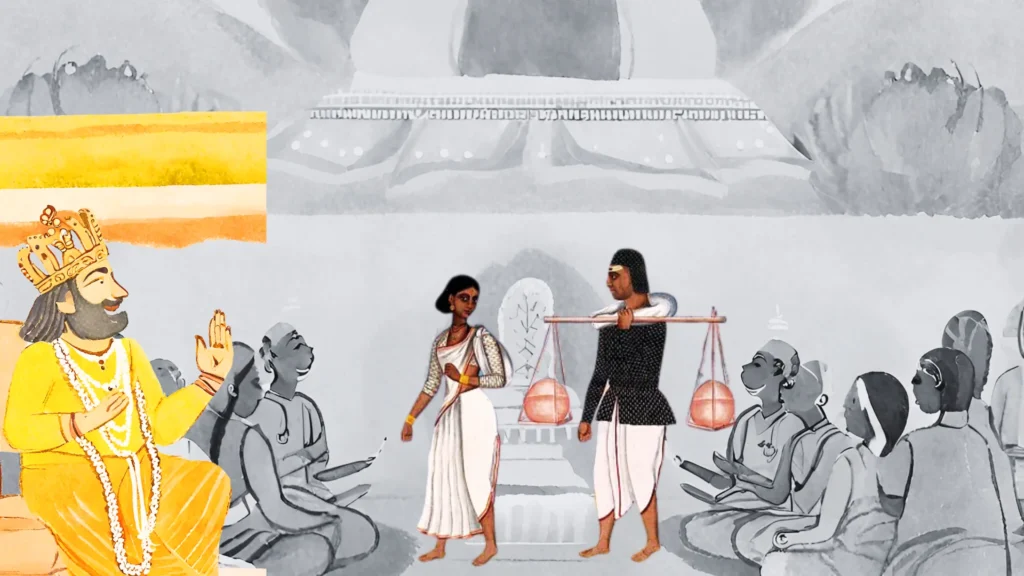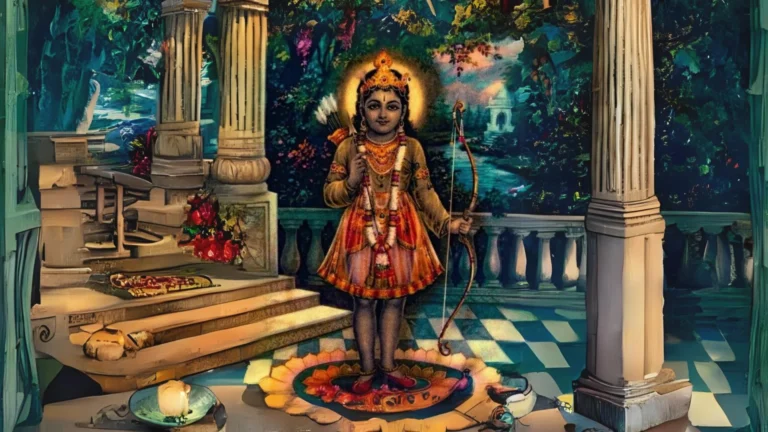Please Like the Blog and Share it for Maximum Reach
Table of Contents
The Azhvars were most elevated devotees of Sri Vishnu. In one of Nam-Azhvar’s Paushurams (Poetic descriptions), he describes the character of Manthara.
Description of Manthara’s Physical Appearance
He says: “She has tied her hair tightly and has wrapped flowers around it. Bumble bees hum around these unique flowers which keep releasing honey and fragrance. Thus, is the hair-do of the ‘bent-one’”
(Kooni கூனி another name for Manthara).
The initial lines describing her hairstyle might create the best of imagination in the minds of people. But, on having a closer look at the description we find that he used the word ‘Kooni’ which means bent.

What was he trying to communicate?
Nama Alvar tries to convey that the flowers are beautiful, but they are adorning the hair of the hunched back, Manthara. The flowers adorn the one who is bent in form, intentions and character.
Sri Rama Plays pranks on Manthara
There is a small anecdote in the Ramayana where it is said that Sri Rama, as a five year old boy would wrap a mud ball around the tip of his arrow and shoot it at the hump of Manthara.

When Manthara was targeted by the mud ball, released by our young Lord, she would immediately get annoyed. But, she failed to realize that this reaction is what kept the Lord to play such a prank on her. The Lord would enjoy the scene.
Manthara developed hatred for the Lord right from His childhood days. But, after she was subjected to His pranks, her hatred kept growing. She nurtured revenge in her heart. She patiently waited for a whole 20 years for a golden opportunity to avenge her insult.
Here the pastimes of the two Lords, Sri Krishna and Sri Rama deserve a mention.
Comparing Sri Rama and Sri Krishna’s pastimes
Sri Krishna played untold pranks on untold number of people in Vrindavana.
Instead of asking: “What pranks He played?”, it would be better to frame the question: “What pranks he did not play!”
Every single day, He would break pots and steal butter from the houses of the Gopis. Mother Yashoda, would have to confront those Gopis and pacify them. This had become a daily routine. Little Krishna even stole the clothes of the Gopis.

So, His childhood pastimes were filled with pranks alone. Sometimes people may feel that He over-did some of the pranks. Yet, nothing resulted in future times as a consequence of those pranks.
On the other hand this mud-arrow pastime of Sri Rama is considered as the only prank that He played as a child. This pastime has traces of his self as Sri Krishna. But, unlike Sri Krishna who played innumerable pranks on his devotees as well as enemies, Sri Rama played only this one prank in his entire childhood.
Yet, this single prank resulted in His 14 year exile to the forest.
Krishna Teases Manthara?
Parashara Bhatta, the great Vaishnava sage from Sri-Rangam says: “Oh, Krishna I remember your pastime of shooting mud-tipped arrows at the hump of Kooni (the hunched one)”
Now, by his words, one may wonder as to how Sri Krishna could hit Kooni (Manthara), wasn’t that Lord Rama who performed that pastime?
But, here Parashara Bhatta gives a deeper insight into the moods of the two Lords, Sri Krishna and Sri Rama.

What he meant was only Sri Krishna performs such naughty pranks. Sri Rama is so straight that He would never even dream of playing such a prank on even his enemies.
Although, it was Sri Rama who performed this act, Sri Parashara Bhatta could only witness and recall Sri Krishna. So, here he addresses Sri Krishna as the naughty young child who played that prank on Kooni (Manthara).
This explains the fact that Sri Krishna and Sri Rama are the very same entities although there seems to exist myriads of differences between their characters.
The innocent folks of the village could not understand why Parashara Bhatta called Sri Krishna as Sri Rama, because his mood was an elevated one.
Test your Alignment with the Spiritual Subject Matter (only 7-8 Questions)
The scores generated in this Quiz are relative. There are no right or wrong answers. A percentage towards 100 indicates that you are more aligned to the overall subject matter.
Who is the thief’s Murderer?
The locals tell an interesting story about a thief, comparing that story with Parashara Bhatta’s explanation. The story goes something like this:
A thief climbed up the wall of a newly constructed mansion with a bamboo stick. Since the walls were wet, he lost balance as the bamboo stick slipped from its position. The thief fell down and died.

Now, his wife went up to the King and said: “Your highness, my thief-husband is dead now. He slipped because of a wet wall. You should kindly enquire into the matter.”
The King did not ask as to why the thief committed thievery. Instead, he summoned the mason who was in charge of constructing the new palace walls.
The King starts his enquiry
The king enquired as to why the walls were wet. The mason said, “Yesterday the quantity of water seemed to be more. So, Your Highness I used the excess water to wet the walls. Maybe, the wetness remained for the entire night. I think the water-supplier delivered more water yesterday!”

The King immediately issued summons to the water-supplier. In turn, the water supplier immediately put the blame onto the potter who delivered bigger pots.
Now, the potter was summoned by the King.
The potter said “I saw a beautiful woman that day. Since, I was lost in her thought the entire day, the pots I carved turned out to be much bigger owing to my concentration lapse.”
The king ordered “Alright, bring that woman.”
When the woman arrived at the court, she had her reasons ready.
She said: “Your Highness, normally I do not go that way. But, I had no option that day as the washer-man failed to deliver my clothes the other night. So, I went that way to meet the washer man and enquire about my clothes.”
Hearing these statements, the King started losing his cool now. He thundered “Bring that washer man to me now.”
The King hears the Washer man
The washer man arrived. He started vomiting his reasons for delay. He said “That evening, I could not deliver the clothes to my customer because of a Bhikshu (भिक्षु a mendicant).”
The King: “Because of a Bhikshu!!!”
The washer man: “ Yes, your Highness. The unknown Bhikshu was sitting quietly near the place where I normally wash clothes. Though I insisted that he should move and give me way to perform my chores, he did not budge.

Instead, he silently smiled. Looking at him, I was scared to take any harsh action because I was sure that he had many mystical powers. I waited the whole evening, but he did not move. So, I decided to postpone my work for the next morning. Hence, the delay.”
Now the king was seething with anger.
He yelled: “Get that Bhikshu.”
The mendicant was brought to the court. This fellow had taken a vow of life-long silence. So, naturally he would never utter a word.
The King’s Judgement
The king bombarded a flurry of questions to the mendicant, but the mendicant simply smiled back. The king concluded his action: “Cut this Bhikshu’s head off. Case closed.” The mendicant’s head was severed without much delay.
This is a common tale told in the houses of South India to explain that – someone else is held responsible for an action, though he had nothing to do with an event in the real world. Just like the innocent Bhikshu had to bear the consequence for something he was not responsible.
Krishna takes the name for Sri Rama’s Pranks
Similarly, Sri Rama shot arrows at the hump of Manthara, but the blame went to Sri Krishna, who had nothing to do with the events that followed in Ayodhyaji.
Leela (transcendental pastimes not understood normally by common men of the world) is a term that is used most commonly for Sri Krishna. Rarely do we hear people saying “Rama Leela”.
Manthara: Queen Kaikeyi Marches towards the Kopa Bhavan
Manthara used all her histrionics to influence Kaikeyi. In the end, she became successful. She ordered Kaikeyi “Go to King Dasharath and immediately ask for your two pending boons.”
Getting mesmerized like a snake after hearing the tunes of a snake charmer, Kaikeyi, marched towards the Kopa Bhavan (कोप भवन). Kopa Bhavan is a palatial room adjoining the palace where the queen or king enters, when she/he is angry.

Kaikeyi now with disheveled hair, dressed in white clothes (as if widowed), without ornaments, went into there to bring her plan into action. So, why were Kopa Bhavans made. Can’t Kaikayi seek the two boons in her own palace?
The answer is No. She can’t. There is an important concept behind Kopa Bhavan.
Significance of a Kopa Bhavan
It is believed that all emotions within a living entity add up to create a pleasant or unpleasant circumstance or event. It is mass consciousness that directly impacts the state of environment.
The days of yore were designed in line with Vedic Shastra. An angry man, although quite, may create great turmoil, just by his/her seething moods of the heart. It is the intensity of the vibration that manifests as everything we see around.
Just like growing anger and hatred between 2 countries eventually results in war. Hence, a Kopa Bhavan was built in every kingdom during Vedic times, to arrest anger in the 4 walls of the room and prevent it from negatively impacting the entire Kingdom.
It is common that there may be disagreements between the king and the queen, because they are householders. However, care was taken that their moods did not directly infiltrate into the common man.
A King and queen were considered to be the direct parents of the entire kingdom. So, their moods would directly reflect on the common man. It was needed that both held high and positive spirits to ensure a peaceful, happy kingdom.
Therefore, in times of anger, the king and the queen retired to the Kopa Bhavan so that their unpleasant mood-energy could be restricted.
Please Like the Blog and Share it for Maximum Reach




